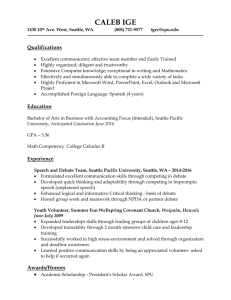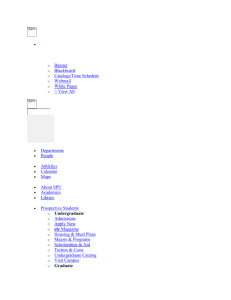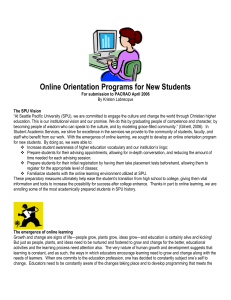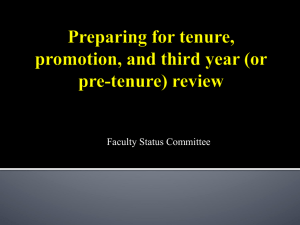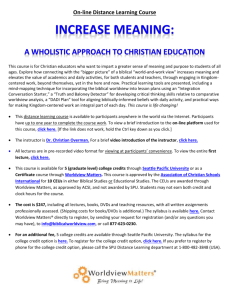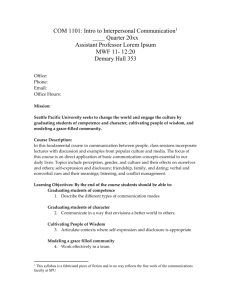to this document in Word ()
advertisement
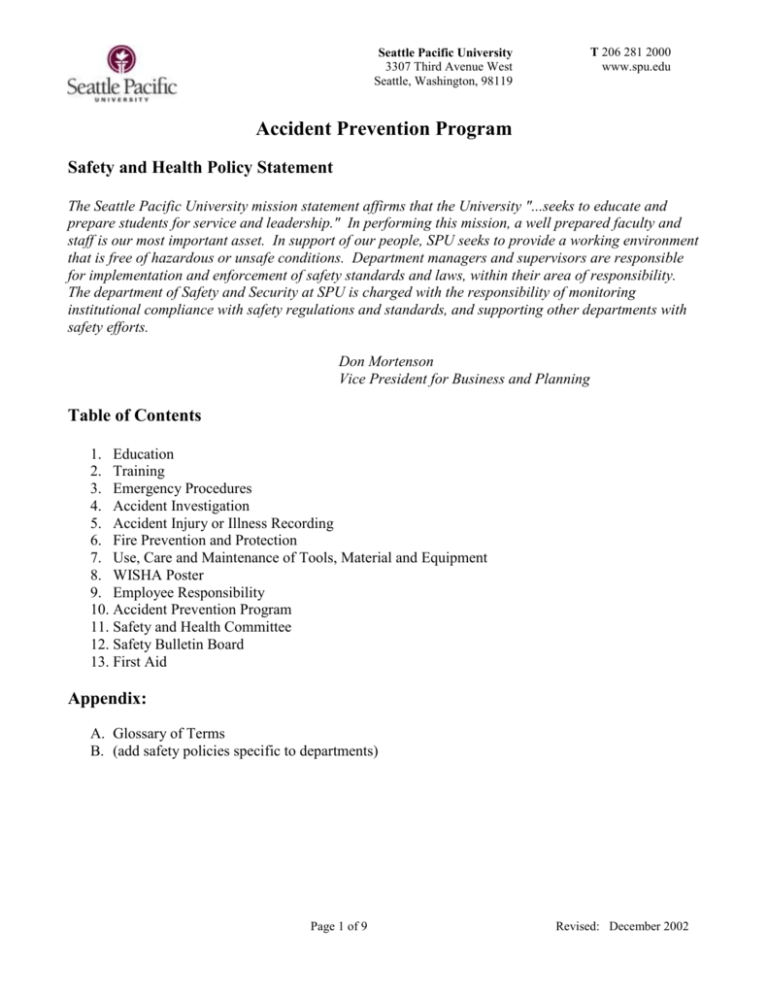
T 206 281 2000 www.spu.edu Seattle Pacific University 3307 Third Avenue West Seattle, Washington, 98119 Accident Prevention Program Safety and Health Policy Statement The Seattle Pacific University mission statement affirms that the University "...seeks to educate and prepare students for service and leadership." In performing this mission, a well prepared faculty and staff is our most important asset. In support of our people, SPU seeks to provide a working environment that is free of hazardous or unsafe conditions. Department managers and supervisors are responsible for implementation and enforcement of safety standards and laws, within their area of responsibility. The department of Safety and Security at SPU is charged with the responsibility of monitoring institutional compliance with safety regulations and standards, and supporting other departments with safety efforts. Don Mortenson Vice President for Business and Planning Table of Contents 1. Education 2. Training 3. Emergency Procedures 4. Accident Investigation 5. Accident Injury or Illness Recording 6. Fire Prevention and Protection 7. Use, Care and Maintenance of Tools, Material and Equipment 8. WISHA Poster 9. Employee Responsibility 10. Accident Prevention Program 11. Safety and Health Committee 12. Safety Bulletin Board 13. First Aid Appendix: A. Glossary of Terms B. (add safety policies specific to departments) Page 1 of 9 Revised: December 2002 Seattle Pacific University 3307 Third Avenue West Seattle, Washington, 98119 T 206 281 2000 www.spu.edu Accident Prevention Program 1. Education Besides the training needed to complete assigned work around campus, continuing education is also an important part of an effective safety program at SPU. The initial safety awareness education for each employee will occur at the employee orientation meeting sponsored by the Office of Personnel. A representative from the Office of Safety & Security will make a presentation, including several elements of safety awareness. Educational safety programs may occur in different formats, depending on the type of work performed by an individual or department. Some of the formats available for use are: posters or announcements placed around the work site which are appropriate to that work area; films, videos or other literature which serves as a refresher course for previously received training; presentations by professionals from outside firms or by qualified and knowledgeable employees of SPU on subjects of general safety and health matters; written reminders sent to employees regarding specific or general health and safety issues; safety meetings and training seminars. Many safety training requirements are set forth by the Department of Labor and Industries to maintain a safe work place. While the Office of Safety & Security develops and recommends many of the safety policies at SPU, various programs and operations at a University often involve hazards that are unique. The management of each department will be responsible for identifying safety concerns for their area of responsibility. Safety and Security has many resources available for training, and they can assist individual departments by consulting on policy or regulations, assisting with training seminars or providing video tapes and other resources. 2. Training The proper training of employees in safety and health matters is a critical part of hazard recognition and control. SPU employees must be trained in those unique requirements of their job that include hazards from personal exposure to chemicals, machines, tools, equipment, or work procedures. For example, a Plant Services employee may need training in the proper uses of various chemicals and cleaning agents, or the dangers associated with operating power tools. However, an office employee who spends several hours each day operating a computer terminal might acquire back, muscle, eye or hand strain and would need training in ways to avoid these conditions. Training may be completed in several forms, depending on the nature of the job and prior experience of the employee. It may be formal classroom, one-on-one in the work area, written or verbal instructions or self taught. There are three levels of training at SPU, depending upon the specific work being done. Level One training is something that the employee can learn about the assigned job on their own by reading a manual or other sources such as a video tape. Level Two training can be done by other qualified personnel at SPU who have demonstrated a proficiency at their job, and have been approved and assigned to train. The following are examples of Level Two training: accident reporting, eye protection, chemical handling, housekeeping, lifting or back care and vehicle safety. Level Three training requires that a certified instructor do all training associated with that job task. A certified instructor can be from within SPU, but that person must have completed all training and received a Page 2 of 9 Revised: December 2002 Seattle Pacific University 3307 Third Avenue West Seattle, Washington, 98119 T 206 281 2000 www.spu.edu Accident Prevention Program certificate allowing them to train others on that job. The following are all Level Three job tasks that require training by a certified instructor: First Aid/CPR Flagging/traffic control Powder activated tools Driving passenger vans Some job tasks at SPU are required by WISHA to have a written program that outlines the safety precautions and training required to do that job. Each written program includes a description of the training provided to employees affected by that program. Copies of these written programs are available through the departments covered by those plans, or at the Safety & Security office. The following are the current required written programs: Accident Prevention Program Asbestos Exposure Assured Grounding Program/Electrical Safety Hearing Protection Blood borne Pathogens Chemical Safety (HAZCOM) Confined Workspace Fall Protection. Fire Brigade Hazardous Waste Lead Exposure Respirators Chemical Hygiene (Laboratories) Lockout/Tagout 3. Emergency Procedures The Office of Safety and Security is trained and equipped to respond to and investigate accidents and hazards on the SPU campus, including fires, crimes and medical emergencies. If there is an emergency, they should be contacted at extension 2911. To report an on campus emergency, do not dial the City of Seattle’s emergency response number of 911. If you do, your call will be automatically received as originating from Demaray Hall and response vehicles may be delayed if an exact location of the emergency is unclear. By dialing extension 2911, SPU phone system can immediately identify the building from which you are calling. Security officers will respond to the location and render appropriate aid that may include notification of the police or fire departments. Most campus buildings are equipped with fire alarm systems that utilize horns or sirens to alert building occupants. In the event of a fire alarm, occupants should evacuate at once via the nearest exit. 4. Accident Investigation Accidents and illnesses on the job result in a no win situation. Employees suffer from injury and SPU suffers from having employees off the job. It is for this reason that our primary goal is to prevent accidents whenever possible. However, when an accident occurs it should always be promptly reported to the Office of Safety & Security at x2911. Accidents requiring in-depth investigation (such as a fatal injury, two or more persons admitted to the hospital or excessive property damage) will also be investigated by an outside agency. Page 3 of 9 Revised: December 2002 Seattle Pacific University 3307 Third Avenue West Seattle, Washington, 98119 T 206 281 2000 www.spu.edu Accident Prevention Program An accident does not have to be of a serious nature to be reported. Any action or activity that has caused an injury to an SPU employee should be reported to the Office of Safety and Security, even if little or no immediate aid is needed. This will help protect the employee by having an objective source check their condition. The Safety and Security Office will also be aware of the situation in the event that it develops into something more serious. Employees are also urged to report “near miss” injuries or accidents, either to their supervisor or Safety and Security. A near miss could be a stumble over an object, a slip, or a falling object that caused no immediate harm. These reports help identify potential hazards or conditions that can be addressed to avoid an injury in the future. Once an accident is reported to Safety and Security, the responding officer(s) will take control of the scene in the following manner: contact appropriate emergency response agencies (police, fire, Haz-Mat, etc.); supervise and administer first aid; arrange for transportation depending on seriousness of the injury; protect injured employees from further injuries; notify appropriate administration officials; protect the scene for investigation; and remain with injured parties until deemed unnecessary. A written incident report will be filed on each reported accident, which will include an investigation into the cause of the accident. Each written report will also be reviewed by the Safety Committee, who will discuss the accident and work towards implementing changes to prevent future accidents of that nature. 5. Accidental Injury and Illness Recording Maintaining accurate injury and illness records is an important part of our accident prevention efforts. Accident recording is more than a legal requirement. It is also a tool used by SPU to help maintain control of hazards. By reviewing these records, SPU can identify unwanted trends that may be developing and take appropriate corrective action before the situation gets out of hand. Besides incident reports, the Office of Safety & Security will record occupational injuries on the OSHA 200 form. Injuries that will be recorded on the OSHA 200 form will meet the following criterion: the injury must have occurred while on company time; the injury involves medical treatment (other than first aid), loss of consciousness, restriction of work or motion, transfer to another job; or there is a death. The OSHA 200 form must be posted in the following offices, Safety & Security, Personnel and Plant Services. The OSHA 200 form must be posted a minimum of thirty calendar days, and be posted no later than February 1 of the following calendar year and may not be removed prior to March 1 of the same year (i.e., the 1993 OSHA 200 form must be up by February 1, 1994, and may be removed March 1, 1994). The OSHA 200 form will also be made available to the Safety Committee for review during the same period. SPU employees will report all job related injuries or illnesses to Safety & Security at x2911, who will determine if professional medical assistance is required. 6. Fire Prevention and Protection SPU has developed extensive fire prevention and protection measures throughout the campus. Most major buildings on campus have fire detection systems inside which monitor for the presence of smoke or fire and report alarms to the Office of Safety and Security. All buildings are equipped with fire Page 4 of 9 Revised: December 2002 Seattle Pacific University 3307 Third Avenue West Seattle, Washington, 98119 T 206 281 2000 www.spu.edu Accident Prevention Program extinguishers and some have water hoses, automatic sprinklers or fire suppression systems, depending on the circumstances present. In the event of a fire alarm, all occupants should evacuate the building and await word that it is safe to re-enter. In general, evacuation should be through the nearest available exit. If smoke or fire prevents employees from leaving rooms or offices they should close the door to keep out smoke and call security at x2911 to ask for rescue. Security will inform the Fire Department and direct them to the proper location on campus. All Security officers complete Fire Brigade Training and are also given annual training on fire prevention and SPU’s fire detection systems. The Office of Safety and Security is equipped with a computerized monitoring station that reports all activated fire alarms. An officer is then dispatched to investigate, and the Seattle Fire Department is notified of the alarm. Any signs of fire or smoke should be reported to Safety and Security at x2911. All “hot work” (welding, soldering, pipe sweating, etc.) done on the SPU campus, must be reported to Safety and Security by the person doing the work. The dispatcher will then contact the Seattle Fire Department and attain a validation number for a Hot Work Permit. While the work is being done, the person doing the work must keep the provided stub, which includes the validation number. All hot work done away from certified welding stations must have a hot work permit. Hot work permits can be issued for 3 units or less and for no longer than 20 days. Work that will take longer than 20 days will need a separate permit. Pursuant to WAC 296-24-69503, a second person must be standing by as a fire watch whenever hot work is performed in locations where there is risk of fire spreading, or where any of the following conditions are present: Combustible materials are located within 35 feet of the hot work; Combustible materials, even if located more than 35 feet away are easily ignitable; Wall or floor openings within 35 feet expose combustible materials in adjacent areas, including concealed spaces in floors or walls; or Combustible materials that are adjacent to metal walls or partitions that are likely to be ignited by conduction or radiation or heat. 7. Use, Care and Maintenance of Machinery, Tools, Material and Equipment Safe use and care will be practiced of all tools, machinery, equipment or material used by SPU employees on SPU property, regardless of ownership. All supervisors are responsible for monitoring that such items are used properly by the employee(s) and are maintained and remain in good working condition. Employees must know how to properly operate, clean, maintain and recognize when equipment or machinery is no longer safe to use. All tools, machinery, or equipment will be used and maintained according to the manufacturer's recommendations. If such instructions are not available, the manufacturer should be contacted to obtain a new copy. If a new copy cannot be obtained, then qualified persons within the department should be assigned to develop a written set of guidelines for the safe use and maintenance of that item. Instruction Page 5 of 9 Revised: December 2002 Seattle Pacific University 3307 Third Avenue West Seattle, Washington, 98119 T 206 281 2000 www.spu.edu Accident Prevention Program manuals should be kept with each piece of equipment, or at a central location known to all persons using that equipment. 8. WISHA Poster The WISHA poster provides employees with information about their rights under the Washington Industrial Safety and Health Act. The WISHA poster "Job Safety and Health Protection" will be posted in the following offices: Safety & Security, Personnel and Plant Services. Other departments whose activities require a specialized accident prevention program must also display this poster. Any person who notices a damaged or missing poster should report it to the department head in the area where that poster is maintained. 9. Employee Responsibility All employees are required to follow the employee responsibility rules established by the state of Washington found in WAC 296-25-025 which states; 1) Employees shall coordinate and cooperate with all other employees in an attempt to eliminate accidents. 2) Employees shall study and observe all safe practices governing their work. 3) Employees shall offer other safety suggestions, wherein such suggestions may contribute to a safer work environment. 4) Employees shall apply the principles of accident prevention in their daily work and shall use proper safety devices and protective equipment as required by their employment or employer. 5) Employees shall properly care for all personal protective equipment. 6) Employees shall make a prompt report to their immediate supervisor, of each industrial injury or occupational illness, regardless of the degree of severity. 7) Employees shall not wear torn or loose clothing while working around machinery. These rules are posted on the bulletin boards in the following offices: Safety & Security, Personnel and Plant Services. Along with the above state regulations, SPU has established policies that are designed to promote a safe and healthy workplace. These policies are supported by the Office of Safety & Security, the Safety Committee and SPU management. These rules are posted in both the Faculty Staff Handbook and Student Life publication, The Student Handbook. Furthermore, individual departments may have policies for safety that are specific to the work done by them. Each department will be responsible for providing their employees with this information. Failure to follow these rules and guidelines may result in disciplinary action up to, and including termination of employment. Information on this process, including review and appeal, is available in the Faculty Staff Handbook or through the office of Personnel. 10.Accident Prevention Program A safety and health orientation is used to emphasize the importance of work place safety to new employees. The initial safety awareness education for each employee will occur at the employee orientation meeting sponsored by the Office of Personnel. Programs, rules and guidelines that have been Page 6 of 9 Revised: December 2002 Seattle Pacific University 3307 Third Avenue West Seattle, Washington, 98119 T 206 281 2000 www.spu.edu Accident Prevention Program established to protect them are described at this time. A representative from the Office of Safety & Security will make a presentation that includes HAZCOM training, lifting/back care, criminal and medical reporting procedures and the Accident Prevention Program. Crime statistics covering the three previous academic years will be distributed in accordance with the Campus Security Act. A certificate of training for HAZCOM will be filled out by the employee and kept on file in the Office of Personnel. 11.Safety and Health Committee In accordance with WAC 296-24-045, SPU has established the Safety Committee, which meets quarterly to discuss safety issues at SPU. The Committee is composed of six members who represent a cross section of campus life. Four of the members are elected from within the faculty and staff employees and two are appointed by management. For further information on the Safety Committee, refer to the written plan governing it. Copies are available in Safety and Security. 12.Safety Bulletin Board SPU maintains Safety and Health bulletin boards in the offices of Safety & Security, Personnel and Plant Services. Other departments that have written safety programs also have safety bulletin boards. The safety bulletin boards will only be used to post safety and health related materials such as the WISHA poster (form F416-081-000), biohazard posters, the OSHA 200 form or other safety awareness literature. Each of the departments shall include at least the two required postings (the WISHA poster form F416-081-000 and the OSHA 200 form during February) and shall post other labor or health and safety postings based on the nature of the work done in that department. The board shall be monitored and maintained regularly to ensure that posted items are current, related to safety and health issues and are in good condition. 13.First Aid To provide immediate assistance to injured employees, all Safety and Security officers, maintenance supervisors and laboratory supervisors need to maintain current certification in first aid. First aid training will be received from a certified instructor, such as through the American Red Cross. The Personnel Office will maintain a record of all certified personnel and their certification expiration date. All employees who must maintain certification are responsible for monitoring its expiration date and notifying their department director of the need for re-certification. Each department that has first aid certified employees is responsible for arranging initial and subsequent training for them. Page 7 of 9 Revised: December 2002 Seattle Pacific University 3307 Third Avenue West Seattle, Washington, 98119 T 206 281 2000 www.spu.edu Accident Prevention Program Appendix A: Glossary of Terms Accident Investigation: The collection and analysis of information surrounding the circumstances that resulted in an unexpected and undesired event in an attempt to identify and eliminate the causes. Accident Prevention Program: A written set of guidelines designed to systematically identify, eliminate and control conditions and circumstances (hazards) that could cause accidents, injuries and illnesses. Bloodborne Pathogens (BBP): Pathogenic microorganisms that are present in human blood and can cause disease in humans including, but not limited to, hepatitis B virus (HBV) and human immunodeficiency virus (HIV). Codes/Rules/Standards: Written state of Washington instructions concerning subjects regulated by the state to protect people and promote quality of life. They have the force and effect of law. Employee Rights Notification: The posting of notices or other appropriate communication as a method of keeping employees informed of their protection and obligation under the Washington Industrial Safety and Health Act (WISHA). Employee Safety and Health Orientation: The notifying of employees of the basic steps and procedures practiced by the company to ensure a safe and healthful workplace. This notification must be accomplished by a designated individual who refers to written documentation (WAC 296-24-040). General Safety and Health Standards (WAC 296-24): A set of rules established by the state of Washington and provided to guide labor and management in the protection of workers who are or may be exposed to safety ad health hazards. They apply to all places of employment within the state. Some industries have specific standards. General Occupational Health Standards (WAC 296-62): A set of rules established by the state of Washington and provided to guide labor and management in the protection of workers who are or may be exposed to occupational health hazards (i.e., noise, chemicals, etc.). They apply to all places of employment within the state. Hazard: A work condition, practice or method that could cause injury, death or occupational disease. Hearing Conservation: The protection of workers hearing from over exposure to sound levels (noise) by ensuring the use of hearing protectors and engineering of administrative controls. Horizontal Safety/Industrial Health Standards: Written instructions by the state of Washington, concerning subjects regulated by the state to protect workers and promote quality of life. They have the force of law and apply to all places of employment unless excluded by a specific vertical standard. Job Hazard Analysis (JHA): The evaluation of a job through procedures of examining its various tasks to uncover hazards or potential hazards and identifying methods to eliminate the undesired activity. Page 8 of 9 Revised: December 2002 Seattle Pacific University 3307 Third Avenue West Seattle, Washington, 98119 T 206 281 2000 www.spu.edu Accident Prevention Program Lockout/Tagout (LOTO): The placement of a lock or tag onto an energy controlling mechanism (i.e., electrical disconnect valve handle, etc.) to ensure against accidental start up of equipment or machinery. Machine Guarding: The safe guarding of powered motion to prevent accidental contact with hazardous moving points. These may include turning gears, rollers, shafts, belts, chains; the crushing motion of rams, pistons, dies; the cutting of saw blades and shears and similar operations. Policy Statement (Safety & Health): A written documentation that conveys top management's direction concerning safety and health for all employees of that company. It announces a commitment that influences the actions of managers, supervisors, overseers and employees and ultimately determines the effectiveness of the company's accident prevention program. RCW (Revised Code of Washington) & WAC (Washington Administrative Code): Written, state of Washington, instructions concerning subjects regulated by the state to protect people and promote quality of life. They have the force of law. Safety & Health Orientation: The notifying of employees of the basic steps and procedures practiced by the company to ensure a safe and healthful workplace. This notification must be accomplished by a designated individual who refers to written documentation. Safety & Health Committee: A group of management selected and employee elected individuals brought together on common ground to discuss methods and means to reduce, eliminate, and control unsafe conditions and practices in the workplace. It does not replace management's responsibilities and prerogatives but aids top management in providing a safe and healthful workplace for all company employees. Self Inspection: The process of specifically searching for hazards in the workplace. A written checklist is normally used to conduct the inspection. Vertical Safety and Health Standards: Written instructions, by the state of Washington, concerning subjects regulated by the state to protect workers and promote quality of life. They have the force and effect of law and apply to specific industries (i.e., construction, logging, longshore, etc.). They are supplemented by the General Safety and Health and the General Occupational Health standards in areas not specifically addressed in the vertical standard. WISHA: Washington Industrial Safety and Health Act. WISHA Poster: The job safety and health protection poster (F-416-080-000). This document must be posted in all places of employment within the state of Washington. Page 9 of 9 Revised: December 2002
